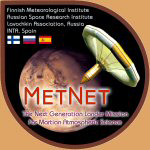
Martian atmospheric investigations
Mars has a thin, cold, dusty and primarily carbon dioxide atmosphere. The Martian atmosphere exhibits a spectrum of circulation phenomena in various spatial and temporal scales; the atmosphere also interacts with the surface and subsurface exchanging heat, momentum and matter (H2O, CO2 and dust). In lowest-temperature conditions even CO2 (the major component of the atmosphere) either condenses onto the surface or forms ice crystals in the atmosphere. H2O condenses at already higher temperatures. The atmosphere carries hence aerosols of three primary species: dust as well as H2O and CO2 ices. They have reservoirs, sources and sinks in the atmosphere, on and within the surface. The aerosols interact with radiation in the solar and thermal wavelengths and have also some lesser effects due to thermodynamic phase changes. The three aerosol populations exhibit feedback of varying significance with atmospheric thermal structure and consequently with circulations.



